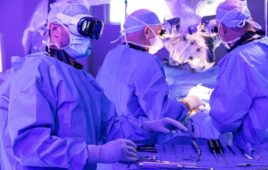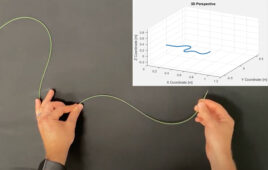 This article appears in the January/February print issue of Surgical Products.
This article appears in the January/February print issue of Surgical Products.
“The future of robotic surgery can be determined only by probing the possibilities. To ignore the potential for extending the boundaries and safety of surgical care with robotic technology seems unwise.”
– (From “The Future of Robotics,”
Bulletin of the American College of Surgeons (July) 2013; 98:9-15.)
It is a spring morning in July 2047.
Dr. Aiden Smith, a surgeon, enters the clinic room and greets Rebekah, the nurse practitioner, who is sitting at the room’s control panel. “Good morning, Rebekah! Looks like our patient tolerated the surgery just fine. How has she been doing?”
“So far, so good, Doctor. Mrs. Morgan had a thyroidectomy last week.”
“Well, let’s take a look at the incision.” He turns to Rebekah and speaks under his breath. “We performed this robotic surgery through her belly button.”
Rebekah helps Mrs. Morgan lie back and exposes the incision. Dr. Smith dons a headset with the words “Clinic Room Operational Computerized Upload Synthesizer” emblazoned on the side. He speaks into the headset. “CROCUS, create a microscope.”
A wall panel opens and a 3-D printer appears. Within seconds, a fully functional operating microscope custom fitted to Dr. Smith’s interpupillary distance and left-handedness emerges from the printer. A robotic arm grasps the microscope and brings it to eye level. Dr. Smith examines the umbilical wound carefully.
Dr. Smith begins to dictate his report. “Everything is healing well. The incision is clean and dry. Both stitches are intact. No evidence of any postoperative complications.”
Dr. Smith adjusts the controls. “CROCUS, deploy the laryngoscope.” A nano-camera on a fiber emerges and inserts itself into Mrs. Morgan’s right nostril, advancing quickly into her throat. The examination table creates a vacuum between itself and Mrs. Morgan that prevents her from moving. “Both vocal cords are mobile. There is a brisk gag reflex.”
“CROCUS, remove the microscope.” The nano-camera retracts and the robotic arm drops the microscope down a chute in the wall. A whooshing sound is heard. The billing total updates.
Rebekah taps Dr. Smith on the shoulder. “Why did you close her incision with stitches? I haven’t seen you use suture since I started working with you! You usually use bioengineered and genetically-compatible adhesive closure devices.”
“Glad you asked, Rebekah! The rep told me about a new suture removal technique and I wanted to try it out. Watch this!” He speaks into the headset. “CROCUS, create a Robotic Suture Removal Device.”
The 3-D printer begins working furiously. A robotic console emerges. Dr. Smith sits down at the console and looks through the eyepieces, his back to Mrs. Morgan. Next, a full-size surgical robot emerges. The arm yanks it over the exam table. As it does so, a puff of smoke emerges from the side of the robot. Mrs. Morgan frowns as she watches wisps of smoke continuing to appear.
“See, Rebekah? In the past, I sometimes pulled too hard when I removed sutures by hand. The company claims that this approach is more precise, causes less pain, and improves patient satisfaction.”
Two robotic arms emerge, one with a diamond-tipped micro-dissecting scissor and the other with a laser-cut articulated precision-matched jeweler’s forceps. The billing total updates. The robot grasps the first stitch and cuts the suture just below the knot. The billing total updates again.
Mrs. Morgan, who has been watching smoke pour steadily from the robot, now notices sparks. She passes out. The robot is quickly engulfed in flames. The sprinkler system activates. Everyone is drenched.
“Dr. Smith!” Rebekah shouts over the deluge, “Mrs. Morgan has fainted! Move the robot so I can get to her!”
Dr. Smith turns with surprise. “CROCUS, extinguish and discard the robot.”
Alarms sound and strobes flash. The flaming robot, now steaming from the sprinklers, is dumped down the chute. A whooshing sound is heard. The billing total updates.
“Wow, Dr. Smith, that was close! But, she still has one stitch left.”
“Well, let’s move her to another examination room and print another robot. I don’t think it would be safe in here with three inches of standing water.”
“Good thinking, Dr. Smith. Safety first! By the way, you failed to initiate the Time Out Checklist before the suture removal.”
Dr. Smith looks at her in horror. “Oh, no! I forgot to initiate a Time Out? Not again! That’s the third time this year!!!”
The 3-D printer springs to life and the robotic arm grabs Dr. Smith, holding him in place as a jail cell emerges and encases him. He sits helplessly on the hard bench, pulls the rough wool blanket around his shoulders, and drops his head into his hands. “Now I’ll never get my charts finished!”
The power supply for the examination table shorts out, which releases Mrs. Morgan. As Rebekah contemplates Dr. Smith’s fate, Mrs. Morgan carefully steps down from the table and quietly sloshes her way out the door.
To subscribe to Surgical Products magazine, click here.




